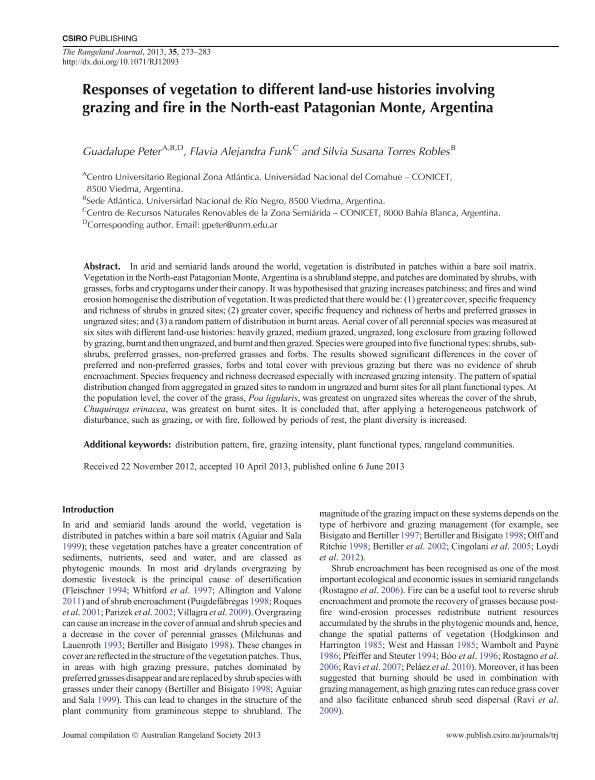Mostrar el registro sencillo del ítem
dc.contributor.author
Peter, Guadalupe

dc.contributor.author
Funk, Flavia Alejandra

dc.contributor.author
Torres Robles, Silvia Susana

dc.date.available
2020-08-06T15:53:03Z
dc.date.issued
2013-06
dc.identifier.citation
Peter, Guadalupe; Funk, Flavia Alejandra; Torres Robles, Silvia Susana; Responses of vegetation to different land-use histories involving grazing and fire in the North-east Patagonian Monte, Argentina; Australian Rangeland Society; Rangeland Journal; 35; 3; 6-2013; 273-283
dc.identifier.issn
1036-9872
dc.identifier.uri
http://hdl.handle.net/11336/111042
dc.description.abstract
In arid and semiarid lands around the world, vegetation is distributed in patches within a bare soil matrix. Vegetation in the North-east Patagonian Monte, Argentina is a shrubland steppe, and patches are dominated by shrubs, with grasses, forbs and cryptogams under their canopy. It was hypothesised that grazing increases patchiness; and fires and wind erosion homogenise the distribution of vegetation. It was predicted that there would be: (1) greater cover, specific frequency and richness of shrubs in grazed sites; (2) greater cover, specific frequency and richness of herbs and preferred grasses in ungrazed sites; and (3) a random pattern of distribution in burnt areas. Aerial cover of all perennial species was measured at six sites with different land-use histories: heavily grazed, medium grazed, ungrazed, long exclosure from grazing followed by grazing, burnt and then ungrazed, and burnt and then grazed. Species were grouped into five functional types: shrubs, subshrubs, preferred grasses, non-preferred grasses and forbs. The results showed significant differences in the cover of preferred and non-preferred grasses, forbs and total cover with previous grazing but there was no evidence of shrub encroachment. Species frequency and richness decreased especially with increased grazing intensity. The pattern of spatial distribution changed from aggregated in grazed sites to random in ungrazed and burnt sites for all plant functional types. At the population level, the cover of the grass, Poa ligularis, was greatest on ungrazed sites whereas the cover of the shrub, Chuquiraga erinacea, was greatest on burnt sites. It is concluded that, after applying a heterogeneous patchwork of disturbance, such as grazing, or with fire, followed by periods of rest, the plant diversity is increased.
dc.format
application/pdf
dc.language.iso
eng
dc.publisher
Australian Rangeland Society

dc.rights
info:eu-repo/semantics/openAccess
dc.rights.uri
https://creativecommons.org/licenses/by-nc-sa/2.5/ar/
dc.subject
DISTRIBUTION PATTERN
dc.subject
FIRE
dc.subject
GRAZING INTENSITY
dc.subject
PLANT FUNCTIONAL TYPES
dc.subject
RANGELAND COMMUNITIES
dc.subject.classification
Ciencias de las Plantas, Botánica

dc.subject.classification
Ciencias Biológicas

dc.subject.classification
CIENCIAS NATURALES Y EXACTAS

dc.subject.classification
Ganadería

dc.subject.classification
Producción Animal y Lechería

dc.subject.classification
CIENCIAS AGRÍCOLAS

dc.subject.classification
Ecología

dc.subject.classification
Ciencias Biológicas

dc.subject.classification
CIENCIAS NATURALES Y EXACTAS

dc.title
Responses of vegetation to different land-use histories involving grazing and fire in the North-east Patagonian Monte, Argentina
dc.type
info:eu-repo/semantics/article
dc.type
info:ar-repo/semantics/artículo
dc.type
info:eu-repo/semantics/publishedVersion
dc.date.updated
2020-04-02T15:10:22Z
dc.journal.volume
35
dc.journal.number
3
dc.journal.pagination
273-283
dc.journal.pais
Australia

dc.description.fil
Fil: Peter, Guadalupe. Consejo Nacional de Investigaciones Científicas y Técnicas; Argentina. Universidad Nacional del Comahue. Centro Universidad Región Zona Atlántica; Argentina. Universidad Nacional de Río Negro. Sede Atlántica; Argentina
dc.description.fil
Fil: Funk, Flavia Alejandra. Consejo Nacional de Investigaciones Científicas y Técnicas. Centro Científico Tecnológico Conicet - Bahía Blanca. Centro de Recursos Naturales Renovables de la Zona Semiárida. Universidad Nacional del Sur. Centro de Recursos Naturales Renovables de la Zona Semiárida; Argentina
dc.description.fil
Fil: Torres Robles, Silvia Susana. Universidad Nacional de Río Negro. Sede Atlántica; Argentina
dc.journal.title
Rangeland Journal

dc.relation.alternativeid
info:eu-repo/semantics/altIdentifier/url/http://www.publish.csiro.au/?paper=RJ12093
dc.relation.alternativeid
info:eu-repo/semantics/altIdentifier/doi/http://dx.doi.org/10.1071/RJ12093
Archivos asociados
